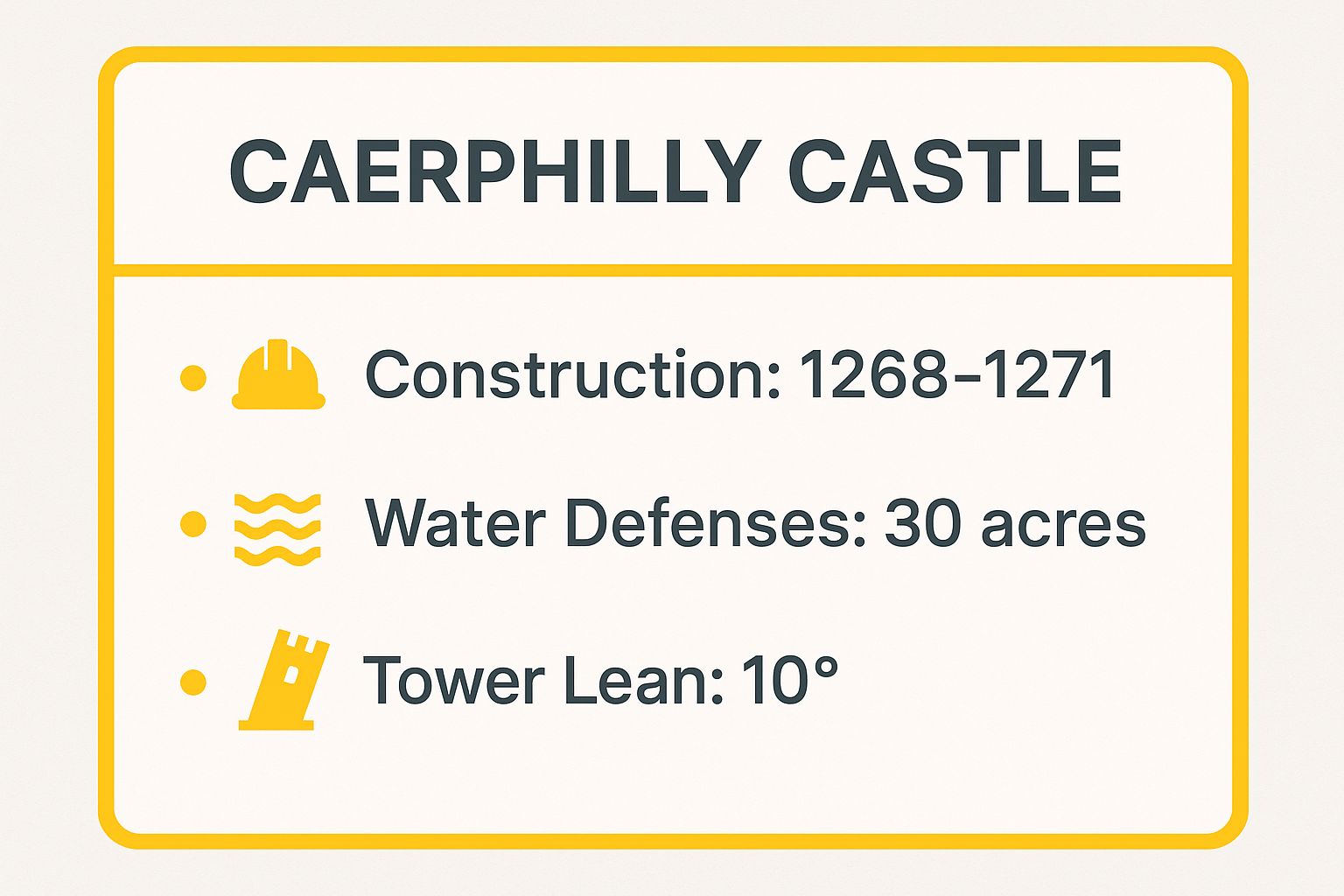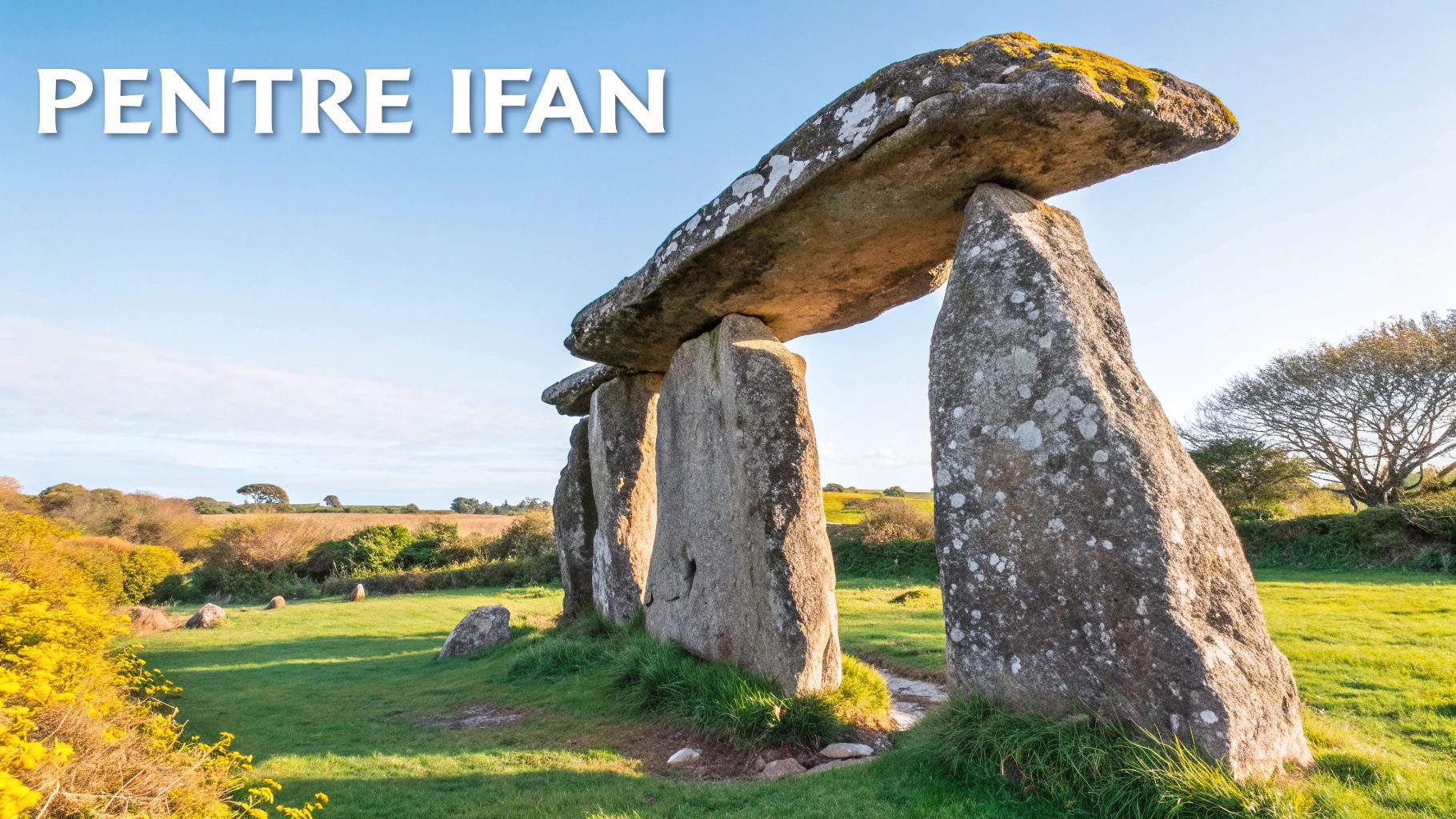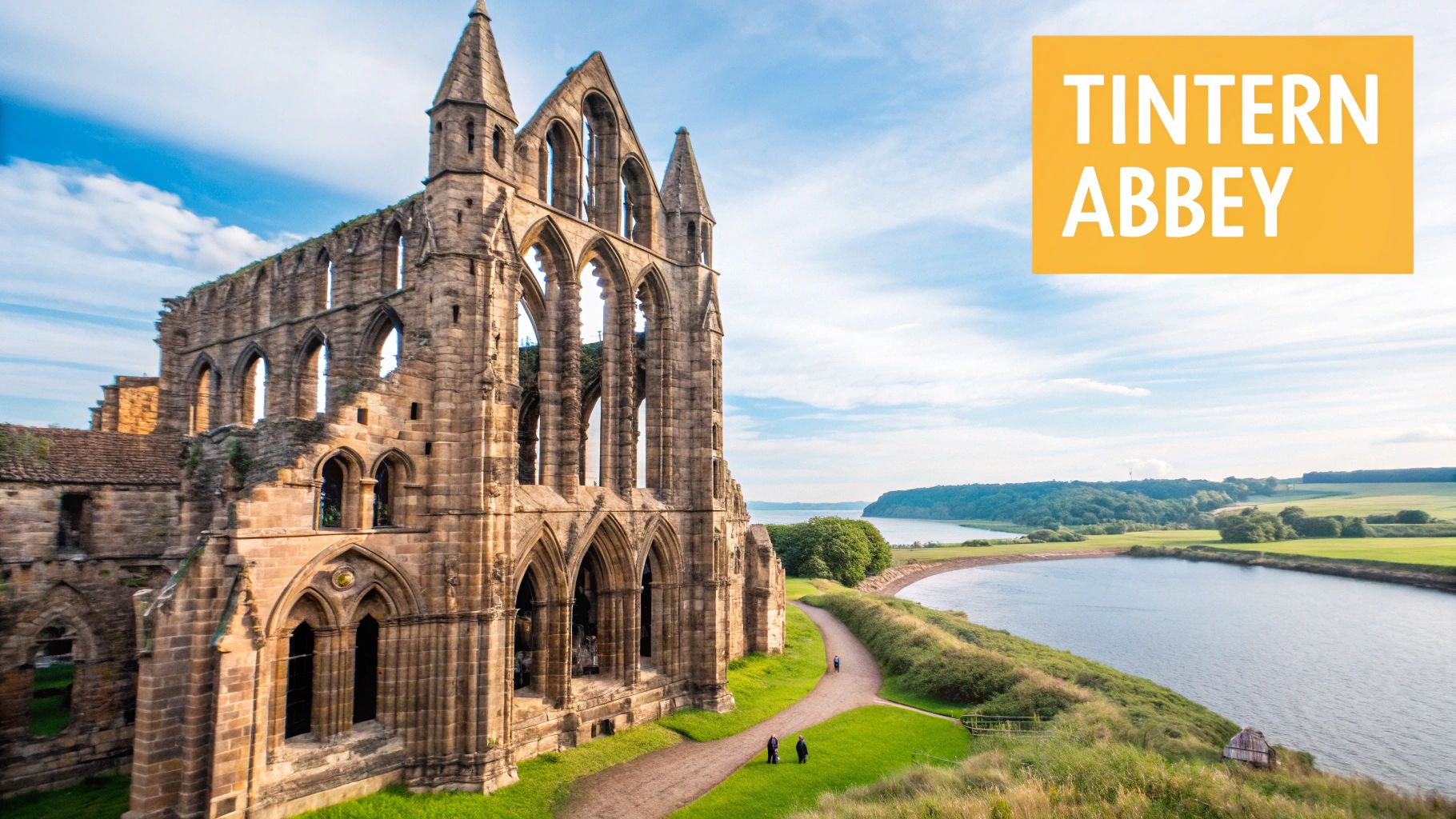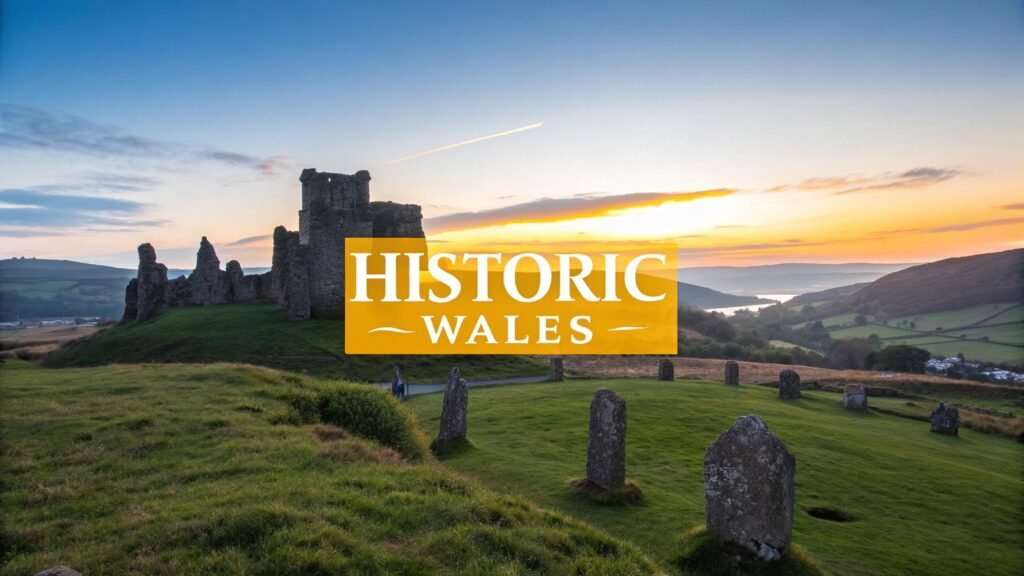Wales, a land of myth and legend, is steeped in a history as dramatic as its landscape. From the Neolithic whispers of Pentre Ifan, a site older than Stonehenge itself, to the formidable 'iron ring' of castles that defined medieval power, every corner of this nation tells a story. This guide is your key to unlocking these tales, offering an in-depth tour of the most significant historic sites in Wales. We will venture beyond simple descriptions, providing practical visitor tips and unique insights to help you plan an unforgettable journey through time.
This curated list focuses on the fortresses, abbeys, and industrial titans that have shaped the very soul of Wales. We'll explore mighty strongholds like Caernarfon and Conwy, which stand as enduring symbols of conquest and resilience. While Welsh castles are unique in their raw, martial design, the UK boasts a rich tapestry of grand structures, including other famous castles like Highclere Castle, each with its own distinct character. Whether you are a history enthusiast, an architecture aficionado, or a family planning a self-drive adventure, prepare to discover the landmarks that chronicle the Welsh story.
1. Caerphilly Castle: The Medieval Water-Girt Giant
Dominating the landscape just north of Cardiff, Caerphilly Castle is an undisputed titan of medieval military architecture and a cornerstone among historic sites in Wales. Built with remarkable speed between 1268 and 1271 by the Norman lord Gilbert de Clare, its primary purpose was to subdue the Welsh prince Llywelyn ap Gruffudd. Its revolutionary concentric ‘walls within walls’ design was a masterclass in defence, but its true genius lies in its vast water fortifications.
The castle is encircled by an elaborate system of artificial lakes and moats covering over 30 acres, creating a formidable water-girt fortress that was practically impregnable to contemporary siege engines. This innovative use of hydrology secured its place in history, a story often recounted in BBC documentaries on medieval warfare. Beyond its defences, the castle is famous for its leaning south-east tower, which tilts at an even greater angle than Pisa’s, a permanent reminder of attempted Civil War slighting.
This quick reference box highlights the staggering scale and speed of the castle's creation.

The data underscores not only the incredible ambition of its construction but also the sheer scale of its defensive network and its turbulent past.
Visitor Tips & Itinerary
- Best Time to Visit: Arrive at opening to enjoy the grounds with fewer crowds and capture the best morning light reflecting off the water.
- Essential Gear: The grounds are extensive. Wear comfortable, sturdy footwear to explore the battlements, towers, and dam platforms fully.
- Planning Your Day: Before you go, check the Cadw website for special events like weaponry demonstrations, which bring the castle’s history to life. For a full-day itinerary, combine your visit with the nearby Llancaiach Fawr Manor, a superbly preserved Tudor house.
2. Conwy Castle: The Pinnacle of Edwardian Military Design
A masterpiece of medieval fortification, Conwy Castle stands as a brute-force statement of power and one of the finest historic sites in Wales. Constructed for Edward I between 1283 and 1287 by his chief architect, Master James of St. George, its purpose was to secure the newly conquered North Wales. As a key component of the 'Iron Ring' of castles, this UNESCO World Heritage Site is celebrated for its remarkable state of preservation and intimidating presence.
The castle's design is a triumph of military engineering, with eight immense, imposing towers and high curtain walls seamlessly integrated with the surrounding fortified town. Its strategic position guarding the Conwy estuary made it a formidable defensive linchpin, a fact often highlighted in historical documentaries analysing Edward I's Welsh campaigns. The castle and its complete circuit of town walls represent one of Europe’s most outstanding examples of late 13th-century military architecture.
The sheer completeness of the castle and town walls provides a unique window into medieval life and strategic planning.
Visitor Tips & Itinerary
- Best Time to Visit: Aim for late afternoon. The setting sun casts a dramatic, golden light on the stone, offering spectacular photo opportunities from the battlements.
- Essential Gear: Good walking shoes are a must. To get the full experience, you'll be climbing spiral staircases in all eight towers to appreciate the commanding views.
- Planning Your Day: After exploring the castle, walk the full circuit of the town walls (approx. 1.3km) for a different perspective. For more information on opening times and events, visit the official Cadw website. A visit can be paired with exploring the smallest house in Great Britain on the quayside below.
3. Pentre Ifan: The Stonehenge of Wales
Set against the dramatic backdrop of the Preseli Hills in Pembrokeshire, Pentre Ifan is Wales' most iconic Neolithic burial chamber and one of the most magnificent historic sites in Wales. Dating back to approximately 3500 BC, this awe-inspiring portal dolmen predates Stonehenge by over 1,000 years. Its famous silhouette is formed by a colossal 16-foot, 16-tonne capstone, which appears to float delicately, balanced on just three of its original upright stones.
Originally the internal stone chamber of a large burial mound that has since weathered away, what remains today is the striking stone skeleton. This ancient monument provides a profound connection to our prehistoric ancestors and has been a subject of fascination for Victorian antiquarians, modern archaeologists, and landscape photographers alike. Its spiritual atmosphere also makes it a popular location for pagan and druidic ceremonies, celebrating its deep roots in the Welsh landscape.

This ancient structure offers a powerful glimpse into Neolithic ritual and engineering. Understanding the history of Pentre Ifan can enrich your visit to this atmospheric corner of Wales.
Visitor Tips & Itinerary
- Best Time to Visit: The golden hours of sunrise or sunset offer the most spectacular photographic opportunities, casting long shadows and bathing the stones in warm light.
- Essential Gear: The monument is located in an open field, often reached via a short walk. Sturdy, waterproof footwear is essential, especially after rain.
- Planning Your Day: Combine your trip with a visit to the nearby Castell Henllys Iron Age Village for a comprehensive journey into ancient Welsh history. For a relaxing end to your exploration, bring a flask and a small picnic to enjoy the peaceful, timeless setting.
4. Harlech Castle: The Cliff-Top Fortress of Legend
Perched dramatically atop a 200-foot rock outcrop overlooking Cardigan Bay, Harlech Castle is a masterpiece of medieval military design and a vital component of Edward I's 'iron ring' of fortifications. Constructed with formidable precision between 1283 and 1287, this UNESCO World Heritage Site was engineered to project English power and suppress Welsh resistance. Its concentric 'walls within walls' layout and commanding position made it a near-impregnable stronghold, a fact proven throughout its storied history.
The castle is most famous for its incredible resilience, having withstood the longest siege in British history during the Wars of the Roses. This seven-year ordeal, along with its earlier capture by Welsh prince Owain Glyndŵr, cemented its place in national folklore and inspired the stirring anthem ‘Men of Harlech’. Its iconic gatehouse and soaring battlements offer breathtaking views across the sea to the mountains of Snowdonia, making it one of the most evocative historic sites in Wales.
This history of prolonged resistance and defiance is a core part of Harlech's identity.
The castle's ability to be supplied by sea via its protected "Way from the Sea" was a strategic masterstroke, allowing it to hold out against land-based sieges for extraordinary lengths of time. This feature was crucial during the seven-year siege.
This design element showcases the advanced military thinking behind its construction.
Visitor Tips & Itinerary
- Best Time to Visit: Aim for a clear day to fully appreciate the panoramic views from the battlements, which stretch across the Llŷn Peninsula and Snowdonia.
- Essential Gear: The cliff-top location is exposed and often windy; bring layered clothing. Comfortable shoes are a must for the steep approach and for climbing the towers.
- Planning Your Day: Check the opening times on the Cadw website before you travel. For an excellent full-day excursion, pair your visit with a trip to the unique Italianate village of Portmeirion, located just a short drive away.
5. St. David's Cathedral: The Spiritual Heart of a Nation
Nestled in a hidden valley on the Pembrokeshire coast, St. David's Cathedral is the spiritual epicentre of Wales and one of its most profound historic sites. The site was founded in the 6th century by St. David himself, the nation's patron saint. The awe-inspiring Norman structure you see today was begun in 1181, built intentionally low in the landscape to hide it from Viking raiders. Its historical and religious significance was immense; a medieval papal decree equated two pilgrimages here with one to Rome, making it a key destination for centuries of faithful followers.
The cathedral's interior is just as remarkable, with its famous sloping floor, intricate carved oak ceiling, and the preserved shrine of St. David. Its enduring legacy is highlighted through its annual St. David's Day celebrations and its role as a sought-after venue for classical music concerts, breathing life into its ancient stones. This site beautifully merges faith, architecture, and national identity, offering a unique tranquillity that contrasts with the military might of other Welsh landmarks.
Visitor Tips & Itinerary
- Best Time to Visit: Attend an Evensong service to experience the cathedral's sublime acoustics and atmosphere. Check service times in advance as they can vary.
- Essential Gear: Comfortable shoes are a must for exploring the cathedral, the extensive grounds, and the adjacent ruins of the medieval Bishop's Palace.
- Planning Your Day: Before travelling, check the St. David's Cathedral website for opening times and to ensure no major services or weddings will restrict access. You can expand your trip into one of the best city breaks by exploring the UK's smallest city and walking a stretch of the stunning Pembrokeshire Coast Path.
6. Caernarfon Castle: A Royal Fortress of Power and Prestige
A masterpiece of medieval architecture and a symbol of English authority, Caernarfon Castle stands as one of the most politically significant historic sites in Wales. Constructed by King Edward I from 1283 as part of his 'iron ring' of fortresses, it was designed not just as a military stronghold but as a royal palace and seat of government. Its imposing, polygonal towers and colour-banded stonework were deliberately chosen to echo the walls of Constantinople, the great seat of the Roman Empire, projecting an image of imperial power.
This UNESCO World Heritage Site is deeply entwined with the British monarchy. It was here in 1284 that the first English Prince of Wales, the future Edward II, was born, establishing a tradition that continues to this day. The castle’s royal connection was powerfully renewed in 1969 when it served as the grand venue for the investiture of Prince Charles, an event broadcast to millions and firmly cementing its place in modern royal history. This blend of medieval might and ceremonial significance makes it a truly unique fortress.
Visitor Tips & Itinerary
- Best Time to Visit: Mid-week mornings are generally quieter. If visiting during a royal anniversary, be sure to book your tickets well in advance to avoid disappointment.
- Essential Gear: Comfortable shoes are a must for ascending the towers. The steps are steep and winding, but the panoramic views from the top of the Eagle Tower are worth the effort.
- Planning Your Day: Allocate at least three hours to explore fully. Start by visiting the Royal Welch Fusiliers Museum housed within the castle walls. Afterwards, take a stroll along Caernarfon’s well-preserved town walls and down to the historic quay for a different perspective of the castle’s dominance over the Seiont estuary. Check the Cadw website for opening times and any special events.
7. Tintern Abbey: The Romantic Ruin of the Wye Valley
Nestled in the serene, wooded landscape of the Wye Valley, Tintern Abbey stands as one of Britain's most atmospheric and poignant monastic ruins. Founded for Cistercian monks in 1131, what visitors see today is the breathtaking shell of the 13th-century Gothic church, a masterpiece of architectural grace. Its roofless nave, soaring arches, and intricate window tracery open to the sky, creating an unforgettable image that has captivated artists and writers for centuries.

The abbey's fame was cemented in the Romantic era, most notably by William Wordsworth's seminal poem 'Lines Composed a Few Miles Above Tintern Abbey' and the dramatic canvases of painter J.M.W. Turner. Their works popularised the abbey as a sublime destination, a place where nature and human creation intertwine. Today, it remains one of the most essential historic sites in Wales, offering a powerful sense of peace and contemplation. The sheer scale of the Gothic structure, stripped to its elegant bones, is a profound testament to its former glory.
Visitor Tips & Itinerary
- Best Time to Visit: Aim for the "golden hour" in the late afternoon when the sun is low. The light streaming through the grand west window creates a truly magical, ethereal atmosphere perfect for photography.
- Essential Gear: A good camera is a must to capture the spectacular views. Also, wear comfortable shoes to explore the abbey grounds and the nearby walking trails that offer stunning vantage points.
- Planning Your Day: Enhance your experience by reading Wordsworth's poem beforehand or while sitting within the ruins. For a full-day itinerary, combine your visit with a scenic walk along the Wye Valley Path or explore the nearby market town of Chepstow and its castle. Check the Cadw website for opening times.
8. Beaumaris Castle: The Unfinished Masterpiece
On the Isle of Anglesey, Beaumaris Castle stands as the ultimate expression of medieval military engineering and a key part of Edward I’s ‘iron ring’ of fortresses. Construction began in 1295 under the legendary architect Master James of St. George, who designed it to be the most technically perfect concentric castle ever built. Its inclusion as a UNESCO World Heritage Site cements its status as one of the most significant historic sites in Wales, representing the pinnacle of defensive design for its time.
The castle's near-perfect symmetry and 'walls within walls' plan created multiple lines of fire, with 164 arrow slits in the outer wall alone. However, due to dwindling funds and shifting priorities in Scotland, construction halted, and the castle was never finished to its intended height. This incompleteness offers a unique insight into medieval building techniques, making it a case study for military architects and a popular setting for historical re-enactments that bring its formidable, albeit unrealised, power to life.
Its unfinished state ironically preserves the purity of its original design, a blueprint of defensive perfection.
Visitor Tips & Itinerary
- Best Time to Visit: Aim for a late spring visit to enjoy pleasant weather before the summer crowds arrive, giving you ample space to appreciate the castle's architectural genius.
- Essential Gear: Bring a guidebook or use an audio guide to fully understand the sophisticated defensive features, such as the ingeniously planned kill zones and angled firing positions.
- Planning Your Day: Allocate at least half a day to see the castle and the charming town of Beaumaris with its colourful Georgian and Victorian buildings. Check the official Cadw website for opening times before your trip and consider combining your visit with other Anglesey attractions like the ancient burial chamber at Bryn Celli Ddu.
9. Blaenavon Industrial Landscape: The Cradle of the Industrial Revolution
Recognised as a UNESCO World Heritage Site, the Blaenavon Industrial Landscape offers a complete and powerful narrative of the forces that shaped modern society. This isn't just a single monument; it is an entire preserved landscape showcasing the dominance of iron and coal in South Wales during the 18th and 19th centuries. The site is a cornerstone for understanding the global Industrial Revolution, providing a tangible link to the technological advancements and social changes that originated here.
The area’s significance is anchored by two key locations: the Blaenavon Ironworks, a remarkably well-preserved example of a 19th-century iron-producing site, and the Big Pit National Coal Museum. This incredible site allows visitors to descend 300 feet underground with a former miner to experience the authentic conditions of a working coal mine. This immersive experience makes Blaenavon one of the most compelling historic sites in Wales, featured in countless documentaries and educational programmes exploring Britain's industrial past.
Visitor Tips & Itinerary
- Best Time to Visit: Aim for a weekday outside of school holidays to ensure a spot on the popular Big Pit underground tour, which can book up quickly.
- Essential Gear: The underground tour is cool and damp. Wear warm layers and sturdy, closed-toe shoes. Above ground, the landscape is expansive, so comfortable footwear is a must.
- Planning Your Day: Dedicate a full day to do the site justice. Start with the underground tour at Big Pit, then explore the surface exhibits. Afterwards, drive to the Blaenavon Ironworks and consider a trip on the Pontypool and Blaenavon Railway. Check the official UNESCO site information before you go for opening times and tour availability.
10. Powis Castle and Garden: Where Fortress Meets Flora
Perched high on a rock above the Severn Valley, Powis Castle offers a unique journey from rugged medieval fortress to opulent baroque country home, making it one of the most distinctive historic sites in Wales. Originally built around 1200 by Welsh princes, it was later transformed by the powerful Herbert family into a grand residence. This unique evolution means visitors can explore both formidable defensive structures and lavishly decorated state rooms side-by-side.
The castle is renowned for housing the Clive Museum, which displays an extraordinary collection of treasures from India and the Far East, brought to Britain by Robert Clive and his family. However, its world-famous terraced gardens are perhaps its greatest spectacle. These dramatic hanging gardens, laid out in the Italian and French styles, descend the hillside with giant clipped yew trees, rare plants, and elegant lead statues, a scene often featured in television programmes like Britain's Best Gardens.
Visitor Tips & Itinerary
- Best Time to Visit: Late spring brings the rhododendrons and azaleas into a riot of colour, while early autumn offers stunning foliage, providing the best garden views.
- Essential Gear: Comfortable shoes are a must for navigating the steep terraces and extensive grounds. A camera is essential to capture the spectacular vistas.
- Planning Your Day: Allow at least three to four hours to fully appreciate both the castle’s interior and the gardens. Before visiting, check the National Trust website for information on special exhibitions in the Clive Museum. To see how this remarkable site fits into a wider tour, you can explore tours that feature Powis Castle.
Top 10 Historic Sites Comparison
| Item | Implementation Complexity | Resource Requirements | Expected Outcomes | Ideal Use Cases | Key Advantages |
|---|---|---|---|---|---|
| Caerphilly Castle | High – advanced concentric and water defenses | Extensive – large grounds, medieval siege displays | Well-preserved military architecture, educational programs | Historical education, medieval reenactments | Exceptional preservation, interactive exhibits |
| Conwy Castle | High – large fortress with town walls | High – multiple towers and extensive walls | Complete medieval fortress experience | Tourism, heritage study, film location | UNESCO site, stunning views, rich history |
| Stonehenge of Wales | Low – ancient megalith construction | Minimal – open field site | Ancient monument visit, photographic/spiritual | Archaeology interest, quiet contemplation | Free access, spectacular setting, ancient site |
| Harlech Castle | High – concentric design on cliff | Moderate – steep access, scenic location | Historic military site with dramatic views | History buffs, scenic tours, cultural events | UNESCO site, rich military history, views |
| St. David's Cathedral | Moderate – medieval Norman architecture | Moderate – active religious site | Spiritual pilgrimage, cultural heritage | Religious services, cultural tourism | Free admission, rich heritage, active worship |
| Caernarfon Castle | High – large polygonal towers, royal chambers | High – multiple levels and royal exhibitions | Politically significant fortress visit | Royal history, castle architecture study | UNESCO site, unique design, royal history |
| Tintern Abbey | Moderate – Gothic monastic ruins | Moderate – preserved ruins and riverside | Romantic cultural heritage, scenic photography | Literary tourism, art inspiration | Atmospheric setting, well-preserved ruins |
| Beaumaris Castle | High – perfect concentric design, incomplete | Moderate – island location, defensive features | Military architecture study, scenic visit | Castle design education, heritage tours | UNESCO site, sophisticated design, well-preserved |
| Blaenavon Industrial Landscape | High – extensive industrial heritage sites | High – multiple museums, underground tours | Industrial revolution education, museum visits | Engineering/history education, museum tours | UNESCO site, authentic mining experience |
| Powis Castle and Garden | Moderate – castle plus elaborate gardens | High – horticulture, art collections | Combined historic and garden visit, cultural enrichment | Garden tourism, historic art appreciation | Magnificent gardens, unique Indo-European collections |
Planning Your Own Welsh Historical Adventure
Our journey through the most captivating historic sites in Wales has taken us from the military precision of Edward I's "Iron Ring" castles like Conwy and Caernarfon to the serene spiritual heart of St Davids Cathedral. We've marvelled at the sheer scale of Caerphilly's water defences, felt the atmospheric hush of Tintern Abbey's graceful ruins, and stepped back millennia at the enigmatic Pentre Ifan. Each site offers a distinct and powerful connection to the nation's past.
The true magic of exploring Wales lies in understanding how these places are woven into the very fabric of the landscape and national identity. The formidable clifftop perch of Harlech Castle tells a story of strategic dominance, while the Blaenavon Industrial Landscape speaks of a world-changing revolution built on coal and iron. These aren't just isolated tourist spots; they are pivotal chapters in the epic tale of Wales, a country shaped by princes, saints, invaders, and innovators.
Crafting Your Itinerary: Next Steps
To transform this list from inspiration into a real-world adventure, a bit of practical planning is key. Here are some actionable steps to get you started:
- Map Your Route: Group sites by region to minimise travel time. For instance, you could create a North Wales itinerary focusing on the UNESCO World Heritage castles of Conwy, Beaumaris, Caernarfon, and Harlech. A southern tour might link Caerphilly, Tintern Abbey, and the industrial heritage of Blaenavon.
- Check Opening Times and Book Ahead: Many historic sites in Wales, particularly those managed by Cadw (the Welsh Government's historic environment service), have seasonal opening hours. Always check their official websites before you travel, and book tickets online to secure your spot and often save a little money.
- Consider a Heritage Pass: If you plan to visit multiple sites managed by Cadw, purchasing a membership can offer excellent value. It provides free entry to over 100 historic locations across the country, allowing for more spontaneous exploration.
- Balance Your Budget: Creating a memorable trip involves more than just entry fees. You'll need to account for accommodation, fuel, and food. When planning your historic adventure, managing expenses is crucial. For broader tips on how to efficiently manage your finances while exploring, consider these budget travel tips.
By embracing these steps, you move from simply seeing historic sites to truly experiencing the profound narrative of Wales. You create a journey that is not just about where you go, but about the stories you uncover and the connections you make with a history that is still vividly alive in the stones, hills, and valleys of this remarkable country.
Ready to explore the rich history of Wales without the hassle of planning every detail? The experts at BTOURS specialise in creating bespoke self-drive tours that connect you with the very best historic sites in Wales. Let them craft your perfect journey through time.



